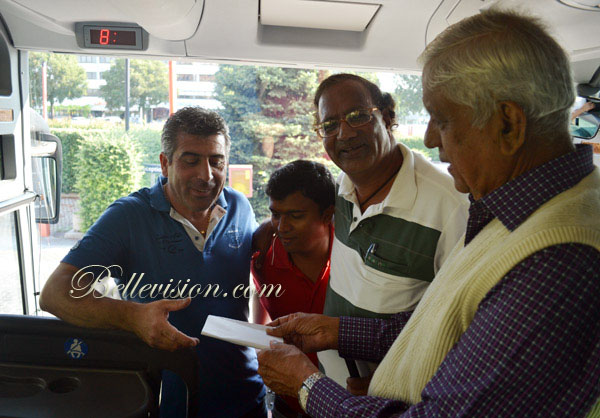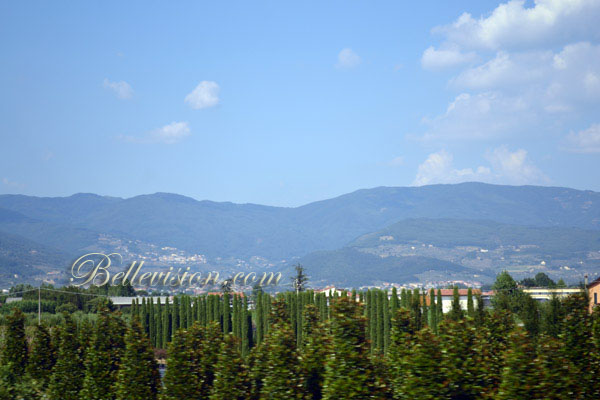Wonders of Europe-Part 9: In the Shadow of the Leaning Tower of Pisa and Glimpses of Florence
By Dr. Eugene DSouza, Moodubelle
Bellevision Media Network
Udupi, 18 Oct 2013: On 22 July 2013, the two important Italian tourist centers that were included in our ‘Wonders of Europe’ tour list were Pisa, famous for the so called ‘Leaning Tower of Pisa’ and Florence known as the city that gave birth to ‘Renaissance’ in Italy.
We left Tulip Inn quite early in the morning as we had to traverse considerable distance between Padua and Pisa. We had to reach Pisa for lunch and later view the historical complex of the Piazza del Duomo (Cathedral Square) where the Leaning Tower of Pisa is situated and next proceed to Florence.
Our Tour Manager, Kunal Gorekar had informed us on the previous night that the Coach Captain, Mr. Alessandro who had been with us for 12 days from Paris would be going on mandatory holiday at Florence and there would be a new Coach Captain for the remaining two days of our stay in Italy. All of us collectively decided to give a small token gift of our appreciation to the service rendered to us by Mr. Alessandro. Before Mr. Alessandro would take the wheel, Mr. C.V. Patil, one of our tour mates spoke few words in appreciation of Mr. Alessandro’s service to us with a smiling face and requested the senior most tourist in the group, Commodore Jerome Castelino to hand over the cash gift to Mr. Alessandro along with Kunal Gorekar. Mr. Alessandro expressed his gratitude and said that we were one of the best tourist groups that he had the opportunity to take drive around Europe.
Having completed the brief felicitation programme we hit the road towards Pisa. Once again the rural Italy provided eye-catching rural topography. The broad highways, typical Italian settlements and agricultural crops were a delight as we passed through Tuscany believed to be one of the most beautiful landscape in the whole of Italy. Both Pisa and Florence are located in this region. As we moved further deeper in Tuscany, I was amazed to see vast fields with sunflowers painting the stretch of land with yellow colour. Clicking pictures through the closed glass windows to get the natural beauty of the flowers was quite difficult. However, I managed to capture few good pictures of sunflower fields for which Tuscany is famous for.
We covered 296 kilometers distance between Padova and Pisa in around four hours with half an hour break in between. On reaching Pisa, first we had lunch in a restaurant managed by Indians just outside the walled Cathedral Square. The area was covered with make-shift stalls selling varieties of goods. We could see Africans as well as Asians, especially from Bangladesh pursuing the tourists and persuading them to buy ladies handbags and other assorted articles. The tourists found for a change that they could bargain forcing the vendors to reduce the quoted price which invariably four or five times the actual price.

.jpg)
.jpg)
.jpg)
.jpg)
.jpg)
.jpg)
.jpg)
.jpg)
.jpg)
After having had our lunch we proceeded to the main gate through which the tourists were entering the Cathedral Square. As I entered the huge arch I got the first glimpse of the three important monuments within the square especially the sight of the Leaning Tower of Pisa, the most recognizable monument in the world.
Pisa is a city in Tuscany, Central Italy, on the right bank of the mouth of the River Arno on the Tyrrhenian Sea. It is the capital city of the Province of Pisa. Although Pisa is known worldwide for its Leaning Tower which is actually the bell tower of the city’s Cathedral, the city of over 88,332 residents contains more than 20 other historic churches, several palaces and various bridges across the River Arno. The city is also home of the University of Pisa, which has a history going back to the 12th century.
The Piazza del Duomo or Cathedral Square is a wide, walled area to the north of central Pisa. It is a sacred area for the Catholic Christian religion, and it is dominated by four great sacred edifices: the Duomo (Cathedral), the Campanile (the cathedral’s free standing bell tower also known as the Leaning Tower of Pisa), the Baptistery and the Campo Santo (the monumental graveyard). Partly paved and partly grassed, it hosts also other buildings such as the old hospital which is now in part the Museum of Sinopias and the Museum of the "Opera del Duomo" or the Cathedral Square Museum.
The first monument as we entered the Cathedral Square is the round shaped Baptistery dedicated to St. John the Baptist, stands opposite the west end of the Cathedral. The round Romanesque building was begun in the mid 12th century in the month of August 1153.
The heart of the Cathedral Square is the medieval Cathedral of the Archdiocese of Pisa, dedicated to St. Mary of the Assumption. This is a five-naved cathedral with a three-naved transept. The church is known also as the Primatial, the archbishop of Pisa being a Primate since 1092. Its Construction of the Cathedral began in 1064 by the architect Busketo, and set the model for the distinctive Pisan Romanesque style of architecture. The mosaics of the interior, as well as the pointed arches, show a strong Byzantine influence.
.jpg)
.jpg)
.jpg)
.jpg)
.jpg)
.jpg)
.jpg)
.jpg)
.jpg)
.jpg)
.jpg)
.jpg)
.jpg)
.jpg)
.jpg)
The massive bronze main doors were the replacement of the original doors destroyed in a fire in 1595. The central door was in bronze and made around 1180 by Bonanno Pisano, while the other two were probably in wood. However worshippers never used the façade doors to enter, instead entering by way of the St. Ranieri’s Door, in front of the Leaning Tower, made in around 1180 by Bonanno Pisano. This huge iron door has panels comprising of scenes from the New Testament such as Annunciation, Massacre of the Innocents, Nativity, Adoration of the Magi, Flight into Egypt, Last Supper, Crucifixion, etc.
The campanile or bell tower also known as the Leaning Tower of Pisa is located behind the Cathedral. Being the last of the three major buildings on the Cathedral Square, its construction began in 1173 and took place in three stages over the course of 177 years, with the bell-chamber only added in 1372. Five years after construction began, when the building had reached the third floor level, the weak subsoil and poor foundation led to the building sinking on its south side.
.jpg)
.jpg)
.jpg)
.jpg)
.jpg)
.jpg)
.jpg)
.jpg)
.jpg)
.jpg)
.jpg)
.jpg)
.jpg)
.jpg)
.jpg)
The building was left for a century, which allowed the subsoil to stabilize itself and prevented the building from collapsing. In 1272, to adjust the lean of the building, when construction resumed, the upper floors were built with one side taller than the other. The seventh and final floor was added in 1319. By the time the building was completed, the lean was approximately 1 degree, or 2.5 feet (80 cm) from vertical. At its greatest, measured prior to 1990, the lean measured approximately 5.5 degrees. As of 2010, this has been reduced to approximately 4 degrees. The tower stands approximately 60m high, and was built to accommodate a total of seven main bells, cast to the musical scale.
After clicking as many pictures of the Leaning Tower of Pisa as possible in all angles and spending some time in the Cathedral Square including the so called ‘window shopping’ in front of various small make-shift stalls we came out of the Cathedral Square, had tea and hopped into the bus and moved onward to Florence, a distance of 84 kilometers which we covered in around one and a half hour. As we passed through the city of Flroence towards the Michelangelo Square, i was amazed to read the signboard of an Indian restauraant bearing the name ’Salaam Bombay’ as the bus passed by that street. After taking us to the Micelangelo Square, our Coach Captain for 12 days bid us good bye and went to his hoemtown and a new Coach Captain-Fabrichino, another Italian took over from there who was with us for the next two days till we reached the Rome Airport on our way back to Mumbai after completing the Wonders of Europe Tour.

.jpg)
.jpg)
.jpg)
Florence is famous for its history, art, architecture and literature. It was a centre of medieval European trade and finance and one of the wealthiest cities of the time, Florence is considered the birthplace of the Renaissance, A turbulent political history includes periods of rule by the powerful Medici family, and numerous religious and republican revolutions.
The Medici Family dominated the ruling class of Florence from 1434. The family controlled the largest bank in Europe. Except for brief periods, the Medici Family ruled Florence till 1737. Their cultural interest led them to patronize arts, architecture, painting and literature. The Medici influence was extended to Rome when three members of its family became Popes. Lorenzo the Magnificent (1449-1492) was the most famous of the Medici rulers. He attempted to make Florence one of the most beautiful cities in the world.
As I tried to recollect the history of Florence, we reached Piazzale Michelangelo (Michelangelo Square). Being on a hill-top, the Michelangelo Square provides a magnificent panoramic view of Florence, and is a popular tourist destination. The famous view from this observation point overlooking the city has been reproduced on countless postcards and snapshots over the years.
.jpg)
.jpg)
.jpg)
.jpg)
.jpg)
.jpg)
.jpg)
.jpg)
.jpg)
.jpg)
.jpg)
.jpg)
.jpg)
.jpg)
.jpg)
.jpg)
.jpg)
.jpg)
.jpg)
.jpg)
.jpg)
.jpg)
.jpg)
Michelangelo Square was built in 1869 and designed by architect Giuseppe Poggi on a hill just south of the historic center. The square, dedicated to the great Renaissance sculptor Michelangelo, has replicas of some of his works found elsewhere in Florence. The most famous among them is the statue of David which dominates the square being installed on a lofty pedestal. The panoramic view captures the heart of Florence from Forte Belvedere to Santa Croce and the bridges crossing the Arno River.
Florence’s cathedral stands tall over the city with its magnificent Renaissance dome designed by Filippo Brunelleschi. The cathedral named in honor of Santa Maria del Fiore is a vast Gothic structure built on the site of the 7th century Church of Santa Reparata, the remains of which can be seen in the crypt.
The cathedral was begun at the end of the 13th century by Arnolfo di Cambio, and the dome, which dominates the exterior, was added in the 15th century on a design of Filippo Brunelleschi. The church was consecrated as soon as the octagonal dome was in place although the façade was only half finished by then.
Due to lack of time, visit to the individual churches or monuments was included in the itinerary of the tour by the company that had arranged the Wonders of Europe Tour. Hence, we had to be satisfied viewing the magnificent and architecturally beautiful city of Florence from Michelangelo Square. After clicking a number of pictures from Michelangelo Square we left for our night halt at Perugia, around 155 kilometers from Florence and reached Hotel Quattrotorri at around 7 pm.
Also Read
Part 1 : ’Wonders of Europe’ - London in a Day
Part 2 : Memorable Tour Through Historic Paris and Enchanting Disneyland
Part 3: Onward to beautiful Brussels and classical Amsterdam
Part 4: Magnificent Cologne Cathedral-Architectural Wonder of Europe
Part 5: Through Black Forest to Cuckoo Clock Factory and Rhine Falls
Part 6: Exciting trip to snow-filled Mt. Titlis and Jungfrau and Cruise in Lucerne Lake
Part 7: Travel through Austria-Exploring the City of Sound of Music and Mozart’s Birth Place
Part 8: Wonders of Europe-Part 8: The splendour of Venice-the City of Canals and Gondolas
 Write Comment |
Write Comment |  E-Mail To a Friend |
E-Mail To a Friend |
 Facebook |
Facebook |
 Twitter |
Twitter |
 Print
Print 

















